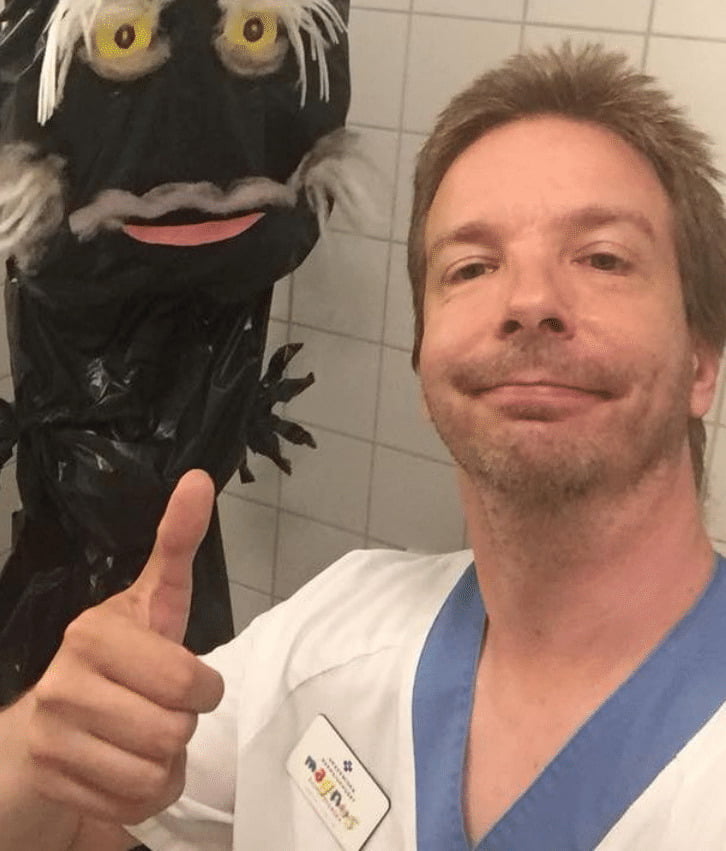Founded in 1708, the Akademiska Sjukhuset, or Uppsala University Hospital, is one of the oldest hospitals in Scandinavia with a long tradition of being first: Sweden’s first nurse was trained at Akademiska which performed the first appendectomy in the Nordics and built the region’s first integrated children’s hospital.
One of the inheritors of this rich clinical heritage is Magnus Grabski, an oncology nurse and system manager for Omda Cytodose. “I started in 2000 for the children’s oncology department,” says Grabski. “In 2007, when Uppsala adopted Omda Cytodose after a tragic compounding error, I was project leader for implementing the solution at the children’s ward and later across the entire hospital.”
Omda Cytodose is the leading medical management system for oncology treatments in the Nordics. Conceived initially to serve only physicians, Cytodose now captures the complete cycle of chemotherapy treatments: to prescribe and order them, to compound them at the pharmacy, and for the productions to be administered to patients by nurses such as Grabski.

By digitalising cancer treatment workflows, Omda Cytodose drives out errors and operational inefficiencies. Because these workflows are most exposed to human error in the interactions between doctor, pharmacist, and nurse, Omda Cytodose is optimally effective when it is used by all relevant healthcare professionals, as is now the case at Uppsala.

The hospital has been open about the nature of the error that led to the introduction of a raft of measures and technologies, including Cytodose. Prior to 2007, pharmacists had to interpret written orders and enter them manually into their own systems; this led to a prescribed 1.5ml being entered and fatally administered as 15ml, “a dose 10 times higher than the child was supposed to receive,” Grabski says.
In this case study we explore how Omda Cytodose helps doctors, pharmacists, and nurses with their critical everyday tasks, and creates a common overview for interacting across an ever-growing number of aspects of oncology treatment at Akademiska.
Grabski plays a central role in this.
From faxing Excel spreadsheets to a cross-functional system
Before the implementation of Omda Cytodose, oncology nurses at Uppsala – while not being formally responsible for clinical decisions and outcomes – bore the brunt of making the treatment workflows as smooth and error-free as possible. Nothing is more powerfully revealing of the changes brought by Cytodose than Grabski’s description of his day-to-day activities before 2007.
“All our chemo workflows were paper-based,” he begins. “We used worksheets from Excel which we printed out for the doctors and eventually faxed to the pharmacy.”
Cytodose improves patient safety, but an additional and related advantage is that the system simplifies the operational structure of oncology treatments, of which there are many. Fully implemented, Cytodose is the operational structure.
“The patient files are in Cytodose now and we can search for them,” says Grabski, “but pre-Cytodose, we had to physically go through filing cabinets and folders to find the correct Excel files with the worksheets for a particular patient. Once I had found the file, I’d print the patient’s name and social security number on them, and then hand the Excel worksheets to the doctor. He or she would look at the patient’s height and weight and calculate the dose based on those parameters.
“They wrote down the prescription,” Grabski emphasises, “and then returned the worksheet to me. I would typically add a note to the pharmacists, such as ‘I need the chemo to be ready on Thursday at 7am’, and then fax the instructions over to them.
“The pharmacy had to manually read the order from my faxed Excel worksheet and key the information into their own system.”
It is at this point that the misreading of 15ml instead of 1.5ml occurred in 2007.

“With Cytodose, this can’t happen anymore,” Grabski continues. “Nowadays, the doctor enters an order into Cytodose, and this is what the pharmacists see in the system. They can’t misread or manually mis-key the prescription.”
The old workflow suffered from poor standardisation in selecting treatments and was riddled with other inefficiencies.
“Instead of signing their orders, doctors often just scribbled their initials on the worksheet, and this could lead to confusion. The pharmacy would have to ring the ward to verify. ‘Who is GL on the fax you just sent? Gunnar Lind, Gunnel Lagerström, or Gert Larsson?’ Not a matter of life or death, but all these minor issues add up in a busy work environment.
“We wasted a lot of time before Cytodose. Doctors are not on call 24/7 so if there was a query about a manifest a different doctor would answer, and you’d have to dig out the right Excel file again. This doesn’t happen anymore because all that information is now accessible in Cytodose.”
Grabski’s old job of physically shuttling pieces of paper between prescribing physician and compounding pharmacy has been taken over by the Cytodose platform, but a nurse still has to pick up the completed productions and of course administer them.
These parts of the workflow are also more time-efficient.
“In the bad old days you’d have the pharmacy time on a whiteboard and then you’d probably have to ring the pharmacists to ask if the order was ready. And if it wasn’t you might have to ring again and so on. Now I can see in the system when an order is ready, and I go pick it up.”
Grabski and other oncology nurses use Omda Cytodose in two other crucial ways: to sign off on administering a pre-defined order to the patient, and to record the clinical parameters related to the cancer treatment.
Oncology patients are typically prescribed a range of non-chemotherapy treatments – blood pressure medication, pain relief, special nutritional needs, and so on. Such information is registered and tracked in the Electronic Patient Journal.
“In Cytodose, we only enter data that are relevant to the ongoing oncological interventions: hydration pre- and post-chemotherapy, blood pressure taken and registered in Cytodose at regular intervals, patient weight in the mornings and evenings to see if they’re retaining fluid, in which case we might have to prescribe diuretics, and so on for all control points indicated by the treatment protocol in ELAS.”
Handover is seamless – that is to say, there is no physical handover from nurse to nurse as they care for the patient because everything is unambiguously stored, tracked and accessible in Cytodose.
“The Excel-based system occasionally led to confusion at the patient’s bedside if the file had been misplaced. So you had to go hunt for it. Sometimes the doctor had to re-do and re-calculate the order which meant that you could end up with a different dose for the same treatment, because the calculation had been rounded up or down. Both 1.2mg and 1.3mg would be a ‘correct’ dose for the patient if the calculation runs to eight decimals, but it used to be distracting, and also a source of potential confusion. But that’s a thing of the past now.”
The relationship with Omda: two-way traffic of insight and learning
Grabski is the Omda Cytodose system manager for the Uppsala University Hospital. “I create new users for the system,” he says, “and educate the doctors and nurses, but not the pharmacists, on how the system works. Another of my responsibilities is recording the software bugs and functional improvements required by our end-users and forward them to the vendor.”
Grabski is also system manager of a different e-health system that has been deployed across the paediatric wards at Uppsala. The comparison with Omda is interesting, he points out. “My contact at the other e-health provider is not a healthcare professional. I sent my bug reports to a techie, not a former nurse, doctor, or pharmacist as is the case with Rasmus [Backström, Omda Application Specialist for Cytodose].
“The people I communicate with at Omda are usually people who have walked in our shoes and understand exactly what I am talking about. Not only that, but they are also interested in what we have to say.”
This dialogue has resulted in a number of improvements to Cytodose.
One example of how Grabski and his colleagues have impacted Cytodose is the introduction of a single template for the full range of compound prescriptions for children. “You have different formulas for calculating doses according to weight and age if the child weighs more than 10kg and is over one year old. But if they weigh less, or are not yet one, the calculations change and that means you need another template.
“We told Omda that it would greatly simplify our lives if we could have a single template for these different scenarios. Omda listened and this is what they built. If I mentioned something like this to other e-health providers they wouldn’t even understand what I was on about.
“But Omda takes the view that Cytodose is there to make our patients safer and to simplify our workflows,” Grabski concludes. “And of course those are our main concerns too. We’re after the same thing and so we talk the same language.”